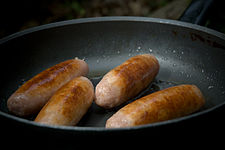Pan frying
Pan frying is a form of frying characterized by the use of minimal cooking oil or fat (compared to shallow frying or deep frying); typically using just enough oil to lubricate the pan (although, in the case of a greasy food such as bacon, no oil or fats may be needed). As a form of frying, pan frying relies on oil as the heat transfer medium and on correct temperature and time to retain the moisture in the food. Because of the partial coverage, the food must be flipped at least once to cook both sides.

Generally, a shallower cooking vessel is used for pan frying than deep frying. Using a deep pan with a small amount of oil, butter or bacon grease does reduce spatter. A denser cooking vessel is better than a less dense pan because that mass will improve temperature regulation. An electric skillet can be used analogously to an electric deep fryer and many of these devices have a thermostat to keep the liquid (in this case, oil) at the desired temperature. The fastest and best way to pan fry is to flip the cooked item very often, about every 15–30 seconds. This will over cook the outside less and get the center cooked faster. Cooking oil is plant, animal or synthetic fat used in frying, baking and other types of cooking. It is also used in food preparation and flavoring that doesn't involve heat, such as salad dressings and bread dips, and in this sense might be more accurately termed edible oil. Cooking oil is typically a liquid, although some oils that contain saturated fat, such as coconut oil, palm oil and palm kernel oil, are solid at room temperature.[1] Types of cooking oil include: olive oil, palm oil, soybean oil, canola oil (rapeseed oil), pumpkin seed oil, corn oil, sunflower oil, safflower oil, peanut oil, grape seed oil, sesame oil, argan oil, rice bran oil and other vegetable oils. Oil can be flavoured with aromatic foodstuffs such as herbs, chillies or garlic. The appropriate amount of fat as a component of daily food consumption is the topic of some controversy. Some fat is required in the diet, and fat (in the form of oil) is also essential in many types of cooking. The FDA recommends that 30% or fewer of calories consumed daily should be from fat.[2] Other nutritionists recommend that no more than 10% of a person's daily calories come from fat.[3] In extremely cold environments, a diet that is up to two-thirds fat is acceptable and can, in fact, be critical to survival